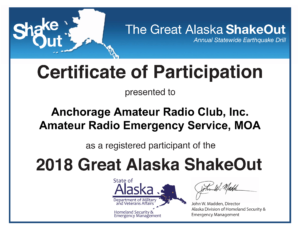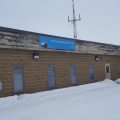Great Alaska ShakeOut 2018 – Area Hams Participate
Hams in the Anchorage, Mat-Su Valley, and Kenai Peninsula areas participated in the 2018 Great Alaska ShakeOut Earthquake Drill on October 18. At the appointed time, 10:18 a.m., from the Radio Science and Operations Center (RSOC) we announced on the KL7ION 147.30/90 repeater that the drill was starting and that pretend shaking had started. At 10:19 a.m., we announced that shaking had stopped, then asked for check-ins. We even posted a bulletin locally on APRS for any stations monitoring to come up on the repeater to participate.
We took this drill as an opportunity for folks to stop and think about where they were, what was in their local vicinity, and how that could be helpful in an earthquake or other disaster scenario. We also wanted participants to see that we were using the 30/90 repeater as a “calling” frequency, and then sent them off to a working frequency to send their reports. Finally, we wanted to see how we could do with use of our underutilized 220 MHz band.
When stations checked in, we asked them if they had 220 MHz capability. If they did, we asked them to shift to 223.5 to call KL7AA to send their reports. If they didn’t have 220 MHz capability we directed them to the Anchorage designated simplex 2-meter frequency of 146.49 MHz. When they checked in on their respective working frequencies, we asked them to simply report their nearest cross street as well as the most prominent infrastructure in their local vicinity; we did NOT ask for damage reports.
A total of 23 stations checked in for the drill from all over the Anchorage area, north to the Mat-Su Valley, and south to the Kenai Peninsula. We had an additional four operators at the RSOC. Everyone did a great job, and, as usual, we had to deal with some adversity!  As early check-ins were sent to 146.49 MHz, we found at the RSOC that we could hear them, but they couldn’t hear us! This went on for about 10 minutes before we finally found that we had a bad triplexer attached to that radio. We pulled the triplexer off and connected the 6-meter to 1.2 GHz log periodic to the radio and the problem was solved.
As early check-ins were sent to 146.49 MHz, we found at the RSOC that we could hear them, but they couldn’t hear us! This went on for about 10 minutes before we finally found that we had a bad triplexer attached to that radio. We pulled the triplexer off and connected the 6-meter to 1.2 GHz log periodic to the radio and the problem was solved.
Participants included:
N9AIG – RSOC net control on the KL7ION repeater
KL5T – RSOC net control on 146.49 MHz
KL6RG – RSOC net control on 223.5 MHz
KL7TS – RSOC Operations Officer
KL7MM – check-in
KL7PHB – check-in
WL7UL – check-in
WL7AQ – check-in
KL4OF – check-in
KL7MO – check-in
KL3JH – check-in
KL7WY – check-in
KD2ERV/M – check-in
KL1JJ – check-in
KL4PL – check-in
KL7JFU – check-in
KL4RQ – check-in
KL7AIR – check-in
KL7XJ – check-in
KL4JW – check-in
KL4JB – check-in
N7DUD – check-in
KL7KO – check-in
KL2AZ – check-in
Thanks to everyone who took a few minutes out of their day to play radio, and special thanks to the RSOC folks who agreed to come out on less than 24 hours’ notice to help with this drill.
I would also be remiss if I were not to ask again for all hams in the Anchorage area who would like to participate in ARES activities (such as this drill), so please officially “register” by clicking on this link. This will help me keep you up-to-date on current ARES happenings.
Lastly, a thank you to PARKA for allowing us to continue to use the KL7ION repeater for ARES purposes.
73,
Kent Petty, KL5T
DEC, Anchorage



